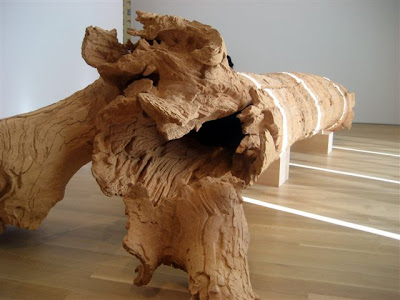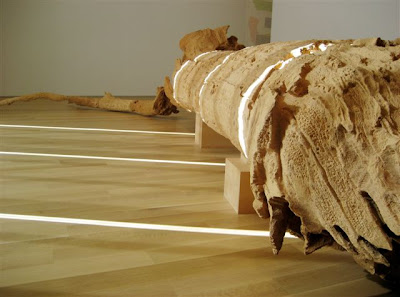I love this video of the novelist Harlan Ellison on You Tube talking with some vehemence--well, ranting (and good for him)--about why he doesn't let his writing be used for free. Change writers to visual artists and you know how I feel about donating to art auctions.
I posted an item on the subject, No, I will Not Donate to Your Auction, on Tuesday, September 11, 2007. I've decided to repost it here with a new postscript:
No, I will Not Donate to Your Auction
Recently a regional museum requested that I donate a small painting to their auction. I said no.
This museum has never shown the least interest in including my work in its thematic shows. Its curators have never expressed sufficient interest in my work to make a studio visit. But they’d be happy to sell it to support their program, which to this date has not supported me. What’s wrong with this picture?
Of course this is not the first time I have been asked to donate work to an auction. If you are an artist, you have been inundated with requests. They’re all good causes: support for museums and art centers, college scholarship programs, AIDS research, breast cancer research. If there’s a need or an illness, there’s an art auction. Here’s the problem: the people least able to afford to donate are the ones repeatedly being asked to give it up. And the ones most able to afford to buy artwork are getting it for a song. What’s wrong with that picture?
Reasons to Donate Your Art
. "It’s great visibility," they tell you. Maybe. If you're an art student or an emerging artist and you pick your causes carefully, yes, you may get some visibility and attention. Some local dealers do look around for who and what’s hot at these events. A collector might acquire a piece at the beginning of your career and remain supportive as your career develops.
. Is there an illustrated catalog? Even midcareer artists might appreciate the boost of a full-page color image and a listing in the "Bibliography" section of your resume.
Reasons Not to Donate Your Art
. Auctions are like Loehmans: they condition collectors to buy lower than retail. This means the rug is effectively pulled out from under your carefully cultivated prices. You’re cheapened.
. Auctions eliminate the dealer. Here’s how the art world works: Artists make the art. Dealers sell it. It’s a symbiotic relationship, because a dealer creates a market for your work, creates a collector base, places the work with private and corporate clients. Undercut the dealer and you undercut your own best interests.
. You get nothing. Zip. Zippo. Nada.
. You can’t even deduct the cost of your work; you can deduct only the cost of materials.
. Think you can put these shows on your resume? Think again. What dealer wants to show an artist who is giving it away? And if the work doesn’t sell, you’re really screwed. Subtext: "This artist can’t even give it away."
How You Can Give
. Ask for a percentage of the sale. Artist-friendly institutions understand that you can't keep giving it away. For emerging artists, it’s a good deal because you get some visibility and a small sum for your work.
. Give cash. Come tax time you can deduct the full price of the donation.
. Look at alternative auction ideas. For instance, I enjoy participating in Postcards from the Edge, part of the Visual AIDS project, which is hosted by a different gallery each year, and Wish You Were Here, the postcard show to benefit A.I.R. Gallery, both in New York. These events draw thousands of people. For each event, I produce a postcard-size painting that will sell for a standard price, about $50.
In most postcard shows, no one signs their name on the front of the postcards, so you could be getting a Faith Ringgold or a Joanne Mattera or a Josephine Schmo. That’s part of the fun. And the price is equally accessible to both artists and collectors. You don’t undercut your price because the price is the same for everyone. What’s more, I appreciate that these institutions understand and respect that they are asking artists to donate work, so they’ve devised a win/win situation.
A Few Suggestions to All the Institutions Who Want My Work and Yours
. Make a high enough minimum so that we’re not cheapened by the sale price.
. Give the artist 50 percent of the selling price (or the option of receiving it).
. Make a good printed catalog with one color image per page. Spell the artists' names correctly.
. Create a well-designed website with images of each artist's work. Spell the artists' names correctly.
. Give us the name of the person who purchases our work so that we can put her/him on our own mailing list.
. Give us a free ticket to the event, not just a ticket with a reduced price.
. Acknowledge our contribution by showing our work in your institutions--not just for the auction.
Oh, and don’t ask too often.
Some of the postcard shows have changed their rules to identify the artist with a wall label. While the mystery is removed, the excitement remains because there's a huge surge early on as collectors look to acquire work from their favorite artists. It's fun! And for artists, next to trading, it's a great way to build a nice personal collection for not a whole lot of money.


. No excuses. If you ask for work and it does not sell, return it immediately. If an artist has to call looking for her work, you have not done your job.
. Working with volunteers? Lay out some working parameters so that they don't throw out packing materials meant to be saved. Or worse, the art itself.
. Understand that when art is lost or damaged, or when the artist or artist's work is not treated with respect, that artist is not likely to donate again to your institution--or any other.
Over to You
Does anyone have horror stories or cautionary tales about donating to auctions? Has inclusion in an auction ever led to additional sales or attention beyond the auction? If you've had a wonderful experience, please share the details. Have you donated to, or purchased from any of the Postcard shows? In other words, fill us in.


.JPG)
.JPG)

.JPG)
.JPG)
.JPG)

.JPG)
.JPG)
.JPG)
.JPG)
.JPG)


.JPG)













































